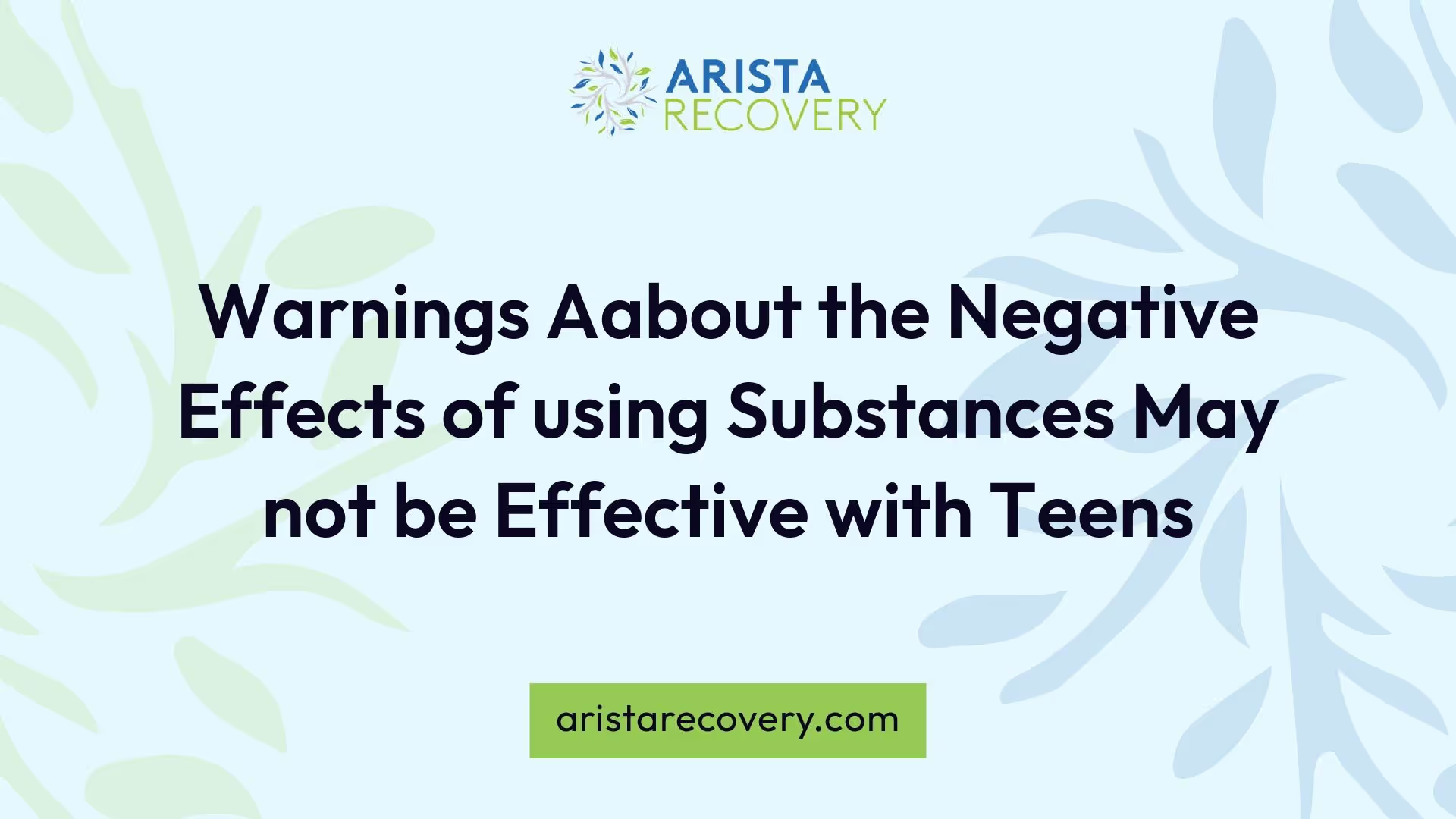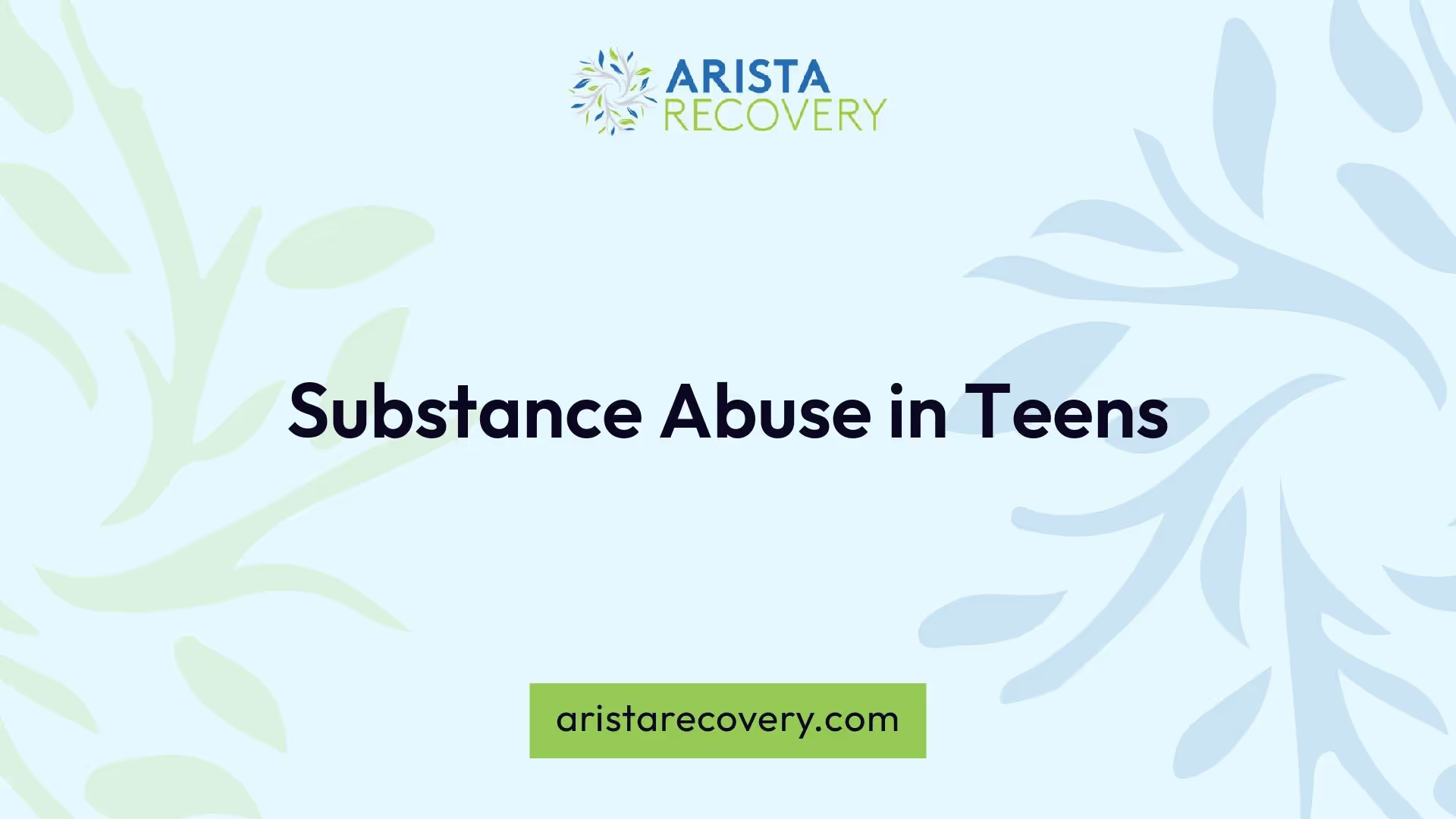Warnings Aabout the Negative Effects of using Substances May not be Effective with Teens

Substance Abuse in Teens

Impact on Developing Brains
Teens are in a critical period of brain development, which continues until they reach their mid-20s. This period is marked by significant changes, particularly in the prefrontal cortex, the area responsible for decision-making. Engaging in substance use during these formative years can interfere with these developmental processes, potentially leading to poor decision-making and increased likelihood of engaging in risky behaviors such as unsafe sex and dangerous driving.
The impact of substances on a developing brain can alter the way teens process information and manage their impulses and emotions. This can lead to a cycle of risky behaviors that have both immediate and long-term consequences.
Commonly Abused Substances
Teens often turn to various substances, and their choices can significantly affect their health and well-being. Some of the most commonly abused substances include:
Teen substance use is often driven by various factors. These may include peer influence, curiosity about the substances, rebellion against family rules, and a sense of invincibility regarding the consequences of their actions [3]. Understanding these influences is key to recognizing warnings of negative effects using substances not effective with teens.
Risks and Consequences

Teen substance use carries significant risks and consequences that can affect both their immediate and long-term health. Understanding these may help in identifying the warnings of negative effects using substances not effective with teens.
Future Substance Abuse
Research indicates a strong correlation between early drug use and later substance abuse problems. As early as adolescence, the likelihood of substance-related issues typically increases, especially among older teens and young adults [4]. The earlier a teenager begins using drugs, the greater the chances of developing a dependency or addiction later in life.
Negative Health Effects
The negative health ramifications of teen drug use can be severe and multifaceted. Abusing substances like alcohol, tobacco, opioids, and illicit drugs (such as cocaine or methamphetamine) can result in health complications, addiction, impairments, and even fatal outcomes [3]. The increase in overdose deaths among teens illustrates the seriousness of these issues, with an alarming 19% rise between 2014 and 2015 [5].
Many teens mistakenly believe that prescription drugs are safer because they are medically prescribed. This misconception can lead to increased rates of abuse, as many young people access these substances from their parents' medicine cabinets, friends, or illegally. Awareness of these risks can facilitate critical conversations about substance use and promote healthier choices among teenagers. For parents, setting a good example can be instrumental in counteracting these trends.
Warning Signs
Recognizing the warning signs of ineffective substance use in teens is crucial for early intervention. These signs can manifest in behavioral changes and physical symptoms, making it essential for parents and guardians to be vigilant.
Behavioral Changes
Often, significant behavioral changes can indicate substance use. These may include:
- Personality Changes: A previously outgoing teen may become withdrawn or vice versa.
- Mood Swings: Rapid and extreme mood fluctuations can signify underlying issues evolving from substance use.
- Irritability: Increased irritability or aggression towards family and friends may be a sign.
- Irresponsibility: Neglecting responsibilities at home or school, including dropping grades and skipping classes.
To summarize, the following table outlines common behavioral changes associated with substance use:
It's vital to look out for these changes and consider potential setting a good example to guide teens toward positive behaviors.
Physical Symptoms
Physical symptoms of substance use can also serve as red flags. Common signs can include:
- Fatigue: Unexplained tiredness or lethargy can be a common symptom.
- Red or Glazed Eyes: Bloodshot or glazed eyes are often visible indicators.
- Lasting Cough: A persistent cough may be indicative of smoking or inhalant use.
- Changes in Appetite or Sleep Patterns: Notable changes in eating or sleeping habits can also arise.
The following table highlights prevalent physical symptoms associated with substance use:
Awareness of these physical symptoms is critical, as they may hint at negative effects linked to substance use, leading to serious health complications including addiction and impairment. Being proactive in addressing these signs can pave the way for necessary interventions, ensuring the health and safety of teenagers.
Influencing Factors
Understanding the factors that contribute to substance use among teens is essential in identifying warnings of negative effects from ineffective substance use. Two significant influencing factors are peer influence and underlying reasons.
Peer Influence
Peer pressure plays a vital role in a teenager's decision to experiment with substances. Many adolescents want to fit in with their friends, which can lead them to engage in drug use even if they had previously decided against it. As noted by the Mayo Clinic, teens often feel the social need to conform to their friends who might be using substances. This desire to belong can result in increased experimentation and potential substance misuse.
Common reasons teens may succumb to peer influence include:
Underlying Reasons
Beyond peer influence, several underlying reasons can motivate teens to use substances. Feelings of loneliness, stress, and curiosity often drive adolescents towards substance use. According to the Mayo Clinic, substances become an option for teens who are facing emotional challenges or trying to rebel against family expectations.
Key underlying reasons for substance use in teens include:
By understanding the impact of peer influence and the various underlying motivations for substance use, parents and guardians can better address the warnings of negative effects using substances not effective with teens. Programs that promote healthy choices and provide support can help mitigate these influences and guide adolescents towards healthier decision-making.
Prevention and Intervention
Parental Role
Parents have a significant influence in preventing substance abuse among their teens. Open communication is key; parents should start conversations early about the dangers of drug use. These discussions can help teenagers make healthier choices in the future. It is important to choose the right time and environment for these conversations to make them more effective [7].
Parents can also serve as good role models by practicing responsible behavior themselves. By demonstrating healthy habits and coping mechanisms, parents can guide their children toward positive decision-making. Recognizing warning signs of teen substance abuse—such as noticeable changes in behavior, physical health, and emotional well-being—is crucial.
By actively engaging in their children's lives, parents can help mitigate risks associated with substance abuse and provide a support system for their children.
Community Programs
Community programs play a vital role in the fight against teen substance abuse. These initiatives often provide education, resources, and support for both teens and parents. Programs can include drug education in schools, support groups, and workshops focused on building resilience and making healthy choices.
Many communities offer referral services for families seeking help, including counseling and treatment options. Establishing strong community ties can create an environment where teens feel supported and valued. Access to resources can empower both teens and their parents to navigate the challenges of substance use effectively.
Communities can encourage parents to participate in these programs as a way to form partnerships aimed at prevention. Enhancing community support structures can significantly reduce the incidence of substance abuse among teens, making it essential for everyone to contribute [8].
By combining the efforts of both parents and community programs, a more robust safety net can be established to address the warnings and negative effects of using substances not effective with teens, ultimately guiding them towards healthier futures.
Strategies for Prevention
Preventing substance misuse among adolescents requires a multi-faceted approach. Two key strategies that have been proven effective are advertising restrictions and screening and interventions.
Advertising Restrictions
Implementing restrictions on the advertising of substances, especially tobacco and alcohol, has been shown to significantly reduce and prevent problematic use among adolescents. Research indicates that limiting exposure to advertisements decreases the likelihood that teens will engage in risky behaviors related to substance use.
By curbing the visibility of these advertisements, communities can foster an environment that discourages substance use among young people.
Screening and Interventions
Effective screening and brief interventions can help identify adolescents at high risk for substance-related problems. Programs that conduct screenings in schools, community centers, or healthcare settings can detect early signs of substance misuse. Once identified, tailored interventions can be provided to those engaged in harmful substance behaviors. Some successful methods include:
- Roadside drug testing to prevent drunk driving
- Needle and syringe programs to minimize injection-related harms
These strategies have demonstrated efficacy in providing timely support and reducing the associated risks of substance use.
By incorporating advertising restrictions and proactive screening measures, communities can create protective factors that resonate with adolescents, ultimately leading to healthier choices regarding substance use. For further insights on the implications of substance misuse, visit our section on teen unsupervised access to prescription meds.
References
[1]: https://medlineplus.gov/drugsandyoungpeople.html
[2]: https://childmind.org/article/mental-health-disorders-and-substance-use/
[3]: https://www.mayoclinic.org/healthy-lifestyle/tween-and-teen-health/in-depth/teen-drug-abuse/art-20045921
[4]: https://drugabusestatistics.org/teen-drug-use/
[5]: https://centerforliving.org/the-most-commonly-abused-substances-by-teens/
[7]: https://www.mayoclinic.org/
You’re not alone in this.
When mental health challenges and addiction intersect, it can feel isolating. At Arista, we offer compassionate, evidence-based, and trauma-informed care to help you heal, grow, and move forward.
You’re not alone in this.
When mental health challenges and addiction intersect, it can feel isolating. At Arista, we offer compassionate, evidence-based, and trauma-informed care to help you heal, grow, and move forward.
Support that moves with you.
You’ve taken a brave first step. At Arista Recovery, we’re here to help you continue with best-in-class care designed for long-term healing and support.
.webp)






